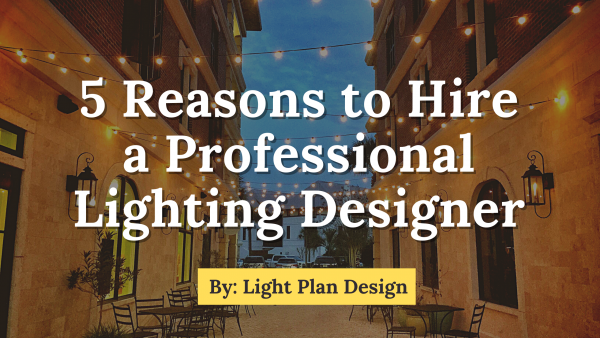In many cases, the bottom line for building Owners is COST. They attempt to cut cost, while still achieving the project of their dreams. Many Owners feel that a project can proceed without the benefits of a professional Lighting Designer. Some Owners feel that the Architect or Engineer can design the lighting, which leads to seeking out the advice of local lighting sales representatives. The pitfall with this process is that the Owner is missing out on the vast knowledge, training and talents of a professional Lighting Designer.
Professional Lighting Designers are actually an added value to a project (detailed below). They are well versed in many different subjects such as aesthetics, lighting fixture types, dimming controls, electrical codes, lighting level requirements, engineering, construction, environmental issues, optics, energy efficient lighting, maintenance issues and operations cost. While this knowledge is extremely important, a Lighting Designer needs to be creative, imaginative, with a strong artistic sense and an ability to create an aesthetically appealing design.
Lighting design is a very creative field, yet a technically interesting subject that requires expertise in a range of disciplines. Skill, knowledge, experience, and the potential to work over a wide range of scales are fundamental components of being a successful Architectural Lighting Designer.
Aside from the Five Reasons to Hire a Lighting Designer presented below, you will have someone on your project team that ‘knows-the-ropes’ of seeing a project through to completion. A Lighting Designer has, over the years, developed a relationship with not only the local sales representatives but also with many manufacturing firms. The Lighting Designer can quickly trouble shoot any issues that might arise. They can intercede with delivery date set-backs, shipment errors, and handle the delivery of partial shipments to keep the construction schedule on track.
1. LIGHTING DESIGNERS ARE ARTISTS
Lighting Designers are well versed in the field of art, with many having some form of formal art training. We at Light Plan Design have team members that come from a theatrical design background and training. We have a strong in-depth artistic training. Light Plan Design treats the designed environment of an architectural project as a canvas to be painted with light. We bring out the textures, the highlights, and the shadows of the environment. We give life to the architectural design.
The environment of a private residence, office building, art gallery, lobby or commercial high-rise all are barren environments longing to be visible, brought to life through light. The Lighting Designer is trained to look at each environment as a unique space, each encompassing a different style. The Lighting Designer interprets and enhances the Architects creation with lighting.
At Light Plan Design, when we first start our design, we don’t concern ourselves with fixture types, but rather with the overall look of the finished product. We envision the environment both by day and at night, completely illuminated. Once the overall mood is set with lighting, we then work out the logistics of achieving our intended goal. This could involve making architectural changes, selecting the appropriate fixtures, making alterations to existing lighting fixtures or designing of custom lighting fixtures to meet our goal.
2. TECHNICAL ASPECTS
A Lighting Designer is trained to create a comfortable environment. To accomplish this many other factors need to be taken into consideration. The task to be performed in the space is crucial. Lighting for office workers, night clubs, art galleries, residences, are all unique. Along with the task lighting for the space, we need to take into consideration social interaction, developing a mood/atmosphere, and contribution to the safety and security of the space. Other important factors to consider are both the quantity and quality of the lighting, alongside the reflected glare, disability glare, visual comfort/discomfort glare and color appearance.
Knowledge of the complexity of the eye, vision, and the eye’s sensitivity to the various wavelengths of visible light is imperative. Color appearance of objects, people and how the color of lighting effects perception are important to also take into consideration.
So, you see, lighting design isn’t just a matter of placing downlights in a ceiling.
3. SUSTAINABILITY
The Lighting Designer must have an understanding of sustainability, ANSI/ASHRAE/IES Standard 90.1-2004, LEED™, and Dark Skies™. We need to talk to the Electrical Engineer and sustainability consultants concerning how the Light Power Density will be calculated, using the room-by-room method or entire building calculation. We need to be aware of spaces that are allowed exceptions, i.e., retail applications. Light Plan Design may be required to create the Comcheck Interior Lighting Compliance Certificate forms. The information for the lighting equipment is on the manufacturers cut sheets, with the Architect supplying the configurations and surfaces in the rooms, to complete the calculations.
When designing exterior lighting a strong understanding of Dark Skies™ and light trespass is critical.
4. COST-CONSCIOUS DESIGN
Aside from being well versed with codes and industry standards, Lighting Designers need to be mindful of cost. Using a different (less expensive) product that you have never used previously involves a lot of research. Obtaining samples to compare different lighting fixtures claiming to produce the same lighting but at different cost is imperative. There are a vast number of manufacturers and comparing quality/cost is critical to maintaining the design intent.
We find that reaching out to the lighting design community, asking about their experience with different products is very helpful.
5. EDUCATION
Lighting Designers are always studying, keeping up with the latest lighting technology (and during these times it is advancing almost daily) and are always looking for more advancements in lighting and lighting controls.
Lighting professionals must be well grounded and continually educate themselves to provide the best possible services. Most qualified Lighting Designers have at least a BA or an MFA in design, plus many years of continuing education.
Continuing education is done in many ways, including networking, reading trade magazines and journals, attending classes/programs, webinars, and presenting seminars. Taking refresher classes and classes on new technology is a must. Many manufacturers offer courses/programs to educate the designer on new technology and their products.
Reputable Lighting Designers have a membership within a recognized lighting organization. To name a few: International Association of Lighting Designers (IALD), International Engineering Society (IES), and the National Council on Qualifications of the Lighting Design Professionals (LC). Many of these organizations require yearly continuing education credits to maintain certification.
CONCLUSION
While avoiding the initial cost associated with hiring a professional Lighting Designer may be attractive to some Owners, it is a short term savings that has a long term adverse impact on a project. Lighting Design brings a project to life, both day and night, and augments the architecture, improving the sense of place and meaning of every project. Skillful lighting design enhances the value of the property and the commercial success of any project by ensuring an aesthetically pleasing environment that also provides enhanced safety and security for the occupants. The performance of the lighting systems also improve worker productivity in office environments and enhance sales in both restaurant and retail environments. The cost of hiring a professional Lighting Designer will pay back many times over during the life of the facility.

